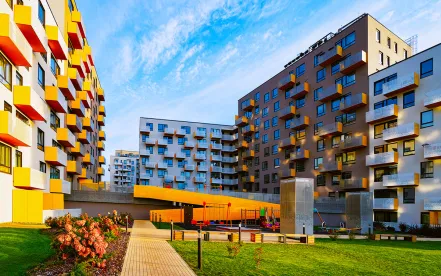On September 16th, hot off the heels of surviving California’s latest recall effort, Governor Gavin Newsom signed into law legislation aimed at addressing the statewide housing crisis – a critical topic leading up to last week’s election. The suite of bills, Senate Bills (SB) 8, 9 and 10 and Assembly Bill (AB) 1174, coupled with the recently announced California Comeback Plan, carry the potential to expand housing production, streamline permitting and promote density closer to major employment hubs.
While the housing deficit in California is undeniable, there is very little consensus on how to combat the crisis. Case in point, nearly 250 municipalities throughout the state opposed Newsom’s most recent signing spree. Led by the League of California Cities, local governments objected that the laws will undermine a local government’s police power, the source of authority for local planning and land use control. There is also concern that these bills are a significant push towards the elimination of single-family zoning statewide. [1]
Below is a summary of the legislation recently passed to fight California’s ongoing housing crisis.
Senate Bill 8
SB 8 extends the provisions of Housing Crisis Act of 2019[2] through 2030. The Housing Crisis Act of 2019, which was scheduled to sunset in 2025, was enacted to jumpstart more housing production by accelerating the approval process for housing projects, curtailing local governments’ ability to downzone, limit fee increases on housing applications and implementing accountability provisions.
Senate Bill 9
SB 9, the California Housing Opportunity and More Efficiency (HOME) Act, is the most contentious bill in the bunch. The source of the bulk of the controversy is SB’s authorization for a property owner to split a single-family lot into 2 lots and place up to 2 units on each newly created lot – resulting in the potential for up to 4 units on properties currently limited to single-family houses. SB 9 also requires cities and counties across California to approve development proposals that meet specified size and design standards.
The Office of the Governor claims these provisions will expand housing options for people of all incomes, create more opportunities for homeowners to add units on their existing properties, all while preventing the displacement of existing renters and protect historic districts, fire-prone areas and environmental quality. However, opponents believe SB 9 undermines the ability of local governments to responsibly plan for the types of housing that communities need, circumvents the local government review process and silences community voices. There is also speculation that a space that once hosted a single home could ultimately size 4 comfortably.
SB 9 is extensive, but the key takeaways are identified below.[3]
-
Access to affordable housing is a matter of statewide concern and not a municipal affair; therefore SB 9 applies to all counties and cities, including charter cities.
-
SB 9 mandates ministerial approval of an application for a housing development, including a parcel map, that splits a parcel into 2 separate parcels and contains no more than 2 residential units on each lot without a hearing if the following requirements are met:[4]
-
The parcel is within a single-family residential zone.
-
If the housing development is located within a city, at least some portion of the boundaries of the parcel must be in an urbanized area or urban cluster, as designated by the United States Census Bureau. Or, if the development is in an unincorporated part of a county, the parcel must be wholly within the boundaries of an urbanized area or urban cluster, as designated by the United States Census Bureau.
-
The split results in 2 parcels of approximately equal lot area. A parcel may not be smaller than 40% of the original parcel’s lot area.
-
Each new lot must be at least 1,200 square feet in size.[5]
-
The project will not demolish more than 25% of the existing exterior structural wall unless permitted by local ordinance.
-
A proposed project or property split does not result in the demolition or alteration of:
-
Affordable or rent-controlled housing;
-
Market-rate housing that has been occupied by a tenant in the past 3 years;
-
The property owner exercised the right to withdraw accommodations from rent or lease within the last 15 years; or
-
The property is listed as a historic landmark or is located within a historic district.
-
-
Any unit created as a result will not be used for short-term rentals, and must be rented for a term longer than 30 days.
-
Property owners have signed an affidavit stating they will occupy 1 of the housing units as a primary residence for at least 3 years after splitting the property or the addition of units.[6]
-
Project adheres to the objective zoning and design review standards established by the local government.
-
The lot split conforms to all applicable objective requirements of the Subdivision Map Act.
-
The parcel being subdivided has not been part of a prior subdivision using the urban lot split process permitted under SB 9.
-
-
Under SB 9, local governments and officials are prohibited from doing the following:
-
Imposing objective zoning standards, objective subdivision standards, and objective design standards that would have the effect of physically precluding the construction of up to 2 units at least 800 square feet in floor area.
-
Requiring a setback for an existing structure or a structure constructed in the same location and to the same dimensions as an existing structure. However, a local government may require a setback of up to 4 feet from the side and rear lot lines.
-
Denying a development application unless a finding can be made that the proposed project would have a “specific, adverse impact” on “public health and safety or the physical environment” and there are no feasible and satisfactory mitigation options.
-
Imposing regulations that require dedications of rights-of-way or the construction of offsite improvements for the parcels being created as a condition of issuing a parcel map for an urban lot split.
-
Imposing additional owner occupancy standards, other than provided for in this subdivision, on an urban lot split.
-
Requiring the correction of nonconforming zoning conditions.
-
-
A local government may require any of the following conditions when considering an application for an urban lot split:
-
Easements required for the provision of public services and facilities;
-
Provision of access for each lot to the public right-of-way; and
-
Off-street parking of up to 1 space per unit, except in specified instances;
-
Limitations on use to residential only.
-
-
SB 9 extends the limit on the additional time period that may be provided for utilization of tentative maps from 12 to 24 months.[7]
Senate Bill 10
SB 10 establishes a voluntary process for local governments to access a streamlined zoning process for new multi-unit housing near transit or in urban infill areas, with up to 10 units per parcel. The legislation simplifies the CEQA requirements for upzoning, giving local governments another tool to voluntarily increase density and provide affordable rental opportunities to more of California.
SB 10 has attracted much less opposition than SB 9.
Assembly Bill 1174
AB 1174 is an urgency measure that amends the existing streamlined, ministerial approval process for housing development in jurisdictions that have not yet made enough progress towards their allocation of their regional housing needs.
California Housing Accelerator
Prior to the recall election, Governor Newsom signed SB 129, legislation that reflects the majority of the 2021-22 state budget agreement. This budget includes the biggest economic recovery package in California’s history – a $100 billion California Comeback Plan.[8]
On September 16th, in conjunction with the suite of enacted housing bills, California announced the California Housing Accelerator – a $1.75 billion component of the California Comeback Plan. The California Housing Accelerator fund is intended to expedite construction of affordable multifamily units in projects stalled due to constraints on the supply of tax-exempt bonds and low-income housing tax credits. Housing officials expect the fund will back 90 shovel-ready projects by the end of the year, creating between 6,300 and 7,200 units of low-income housing – including 1,200 units for homeless individuals. Recipients of the California Housing Accelerator funds have not yet been selected.
While these bills were signed into law, the state legislature was not able to advance 2 other high-profile housing bills – SB 6 and SB 15 – that would have made it easier to turn abandoned shopping malls into apartment buildings.
FOOTNOTES
[1] It is interesting to note that Sacramento officials aim to make California’s capital city one of the nation’s first to eliminate traditional single-family zoning. Portland, Oregon, and Minneapolis, Minnesota have passed similar ordinances in recent years. Oregon passed a law eliminating traditional single-family zoning statewide.
[2] See prior article on the Housing Crisis Act of 2019 here.
[3] SB 9 does not apply to properties in earthquake fault zones and within the “very high” fire hazard zone, unless the development follows state mitigation rules.
[4] Govt. Code § 65852.21, Govt. Code § 66411.7.
[5] A local agency may by ordinance adopt a smaller minimum lot size subject to ministerial approval under this subdivision.
[6] Some requirements do not apply if the applicant is a “community land trust” or a “qualified nonprofit corporation.”
[7] Govt. Code § 66452.6.
[8] The California Comeback Plan invests an unprecedented $22 billion in housing and homelessness, which is intended to lead to the creation of over 84,000 new affordable homes statewide, including over 44,000 new housing units and treatment beds for people exiting homelessness. The California Comeback Plan marks the most significant investment in housing in California’s history with $10.3 billion proposed for housing and over $12 billion for the unhoused.



 />i
/>i

